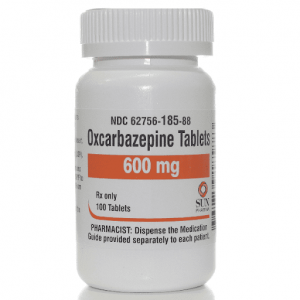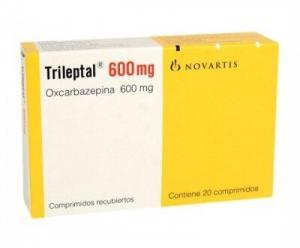Trileptal (Oxcarbazepine)

Dosages
Trileptal 150 mg
| Quantity | Price per pill | Total price | |
|---|---|---|---|
| 60 | $0.85 | $51.00 | |
| 90 | $0.77 | $69.00 | |
| 120 | $0.73 | $88.00 | |
| 180 | $0.69 | $125.00 | |
| 270 | $0.67 | $181.00 | |
| 360 | $0.66 | $236.00 |
Trileptal 300 mg
| Quantity | Price per pill | Total price | |
|---|---|---|---|
| 30 | $2.00 | $60.00 | |
| 60 | $1.60 | $96.00 | |
| 90 | $1.48 | $133.00 | |
| 120 | $1.41 | $169.00 | |
| 180 | $1.34 | $241.00 | |
| 270 | $1.30 | $350.00 |
Trileptal 600 mg
| Quantity | Price per pill | Total price | |
|---|---|---|---|
| 30 | $3.33 | $100.00 | |
| 60 | $2.50 | $150.00 | |
| 90 | $2.22 | $200.00 | |
| 120 | $2.08 | $250.00 | |
| 180 | $1.94 | $350.00 | |
| 270 | $1.86 | $501.00 |
Payment & Shipping
Your order is carefully packed and ships within 24 hours. Here's the typical package.
Sized like a regular personal letter (9.4x4.3x0.3 inches), with no indication of its contents.



| Shipping Method | Estimated delivery |
|---|---|
| Express Free for orders over $300.00 | Estimated delivery to the U.S.: 4-7 days |
| Standard Free for orders over $200.00 | Estimated delivery to the U.S.: 14-21 days |









Discount Coupons
- Independence Day - July 4, 2026 10% JULY410
- Labor Day - September 7, 2026 7% LABOR07
- Thanksgiving - November 26, 2026 9% THANKS09
Brand Names
| Manufacturer | Brand Names |
|---|---|
| Sun Pharmaceutical Industries Ltd. | Oxetol |
FAQ
Description
Brand Name: Trileptal
Active Ingredient: oxcarbazepine
Indication: Treatment of partial epileptic seizures as monotherapy in adults or adjunctive therapy in adults and children as young as age 4
Company Name: Novartis Pharmaceuticals Corporation
Availability: Approved by FDA January 10, 2000
 Trileptal: Introduction
Trileptal: Introduction
More than 2 million people in the US have some form of epilepsy. Seventy percent of them are adults. Although contemporary treatment approaches can provide full or partial control of seizures in about 85% of patients, some 15% of patients do not achieve this control, and many patients are virtually resistant to available drug therapies. Some patients with partial onset seizures - those that originate in one hemisphere of the brain, often without loss of consciousness - resort to surgery to remove the affected area of the brain, ideally without affecting personality or function.
Novartis Pharmaceuticals Corporation recently received FDA approval to market Trileptal (oxcarbazepine), a new drug for both adults and children with partial seizures. The recommended daily doses range from 1200 mg/day as adjunctive therapy to 2400 mg/day as monotherapy in adults (given as two daily doses) and 30-46 mg/kg/day as adjunctive therapy for children ages 4-16.
Trileptal: How It Works
Trileptal activity is primarily exerted through its monohydroxy metabolite (MHD). The precise mechanism by which Trileptal and MHD exert their antiseizure effect is unknown; however, in vitro electrophysiological studies indicate that they produce blockade of voltage-sensitive sodium channels, resulting in stabilization of hyperexcited neural membranes, inhibition of repetitive neuronal firing, and diminution of propagation of synaptic impulses. These actions are important in the prevention of seizures spreading in the brain.
 Trileptal: Clinical Study Results
Trileptal: Clinical Study Results
Six multicenter randomized, double-blind controlled trials established Trileptal's efficacy in adults and children. Four of these studies demonstrated Trileptal's effectiveness as monotherapy. One trial was conducted in 102 adult patients with refractory partial seizures who had been withdrawn from other antiepileptic drugs (AEDs) and received either placebo or Trileptal. Trileptal was given 1500 mg/day on day 1 and 2400 mg/day afterward for an additional 9 days. During the 10-day study period, Trileptal patients experienced significantly fewer partial seizures than placebo patients.
Similar results in favor of Trileptal were observed in a study of 67 untreated patients with newly diagnosed and recent-onset partial seizures who began treatment with either placebo or 300 mg Trileptal twice daily. Trileptal was titrated to 1200 mg/day (600 mg twice daily) in 6 days, followed by maintenance treatment for 84 days.
A third study substituted Trileptal monotherapy 2400 mg/day for carbamazepine in 143 patients whose seizures were inadequately controlled by carbamazepine at a stable dose of 800 to 1600 mg/day. The Trileptal dose was maintained for 56 days. Patients who were able to tolerate 2400 mg/day of Trileptal during carbamazepine withdrawal were randomized to receive either 300 mg/day or stay on the 2400 mg/day dose. After an observation period of 126 days, patients who received 2400 mg/day of Trileptal experienced significantly fewer seizures than those on the 300 mg/day dose.
Similar results in favor of the 2400 mg/day dose of Trileptal were observed in a fourth monotherapy trial conducted in 87 patients whose seizures were inadequately controlled on 1 or 2 AEDs. Patients were randomized to receive either 2400 mg/day or 300 mg/day Trileptal while eliminating their standard AED regimen over 6 weeks. Seizure frequency was evaluated over an additional 84 days.
Two studies assessed the efficacy of Trileptal as adjunctive therapy for partial seizures in 692 adults and 264 children (3-17 years of age). In both trials, patients were stabilized on optimum dosages of their concomitant AEDs during an 8-week baseline phase. Patients were randomized to receive either a placebo or a specific dose of Trileptal in addition to their other AEDs. Adults were followed for 24 weeks, while children were observed for 14 weeks. The adults received fixed Trileptal doses of 600, 1200, or 2400 mg/day, while the children received 30-46 mg/kg/day. Trileptal significantly reduced seizure frequency at all doses tested. In the group of adults receiving 2400 mg/day Trileptal, however, more than 65% of the adults discontinued treatment because of adverse events.
Trileptal: What the Patient Should Know
Trileptal may render hormonal contraceptives less effective, so other non-hormonal forms of contraception are recommended in women taking Trileptal (particularly since Trileptal may have the potential to result in congenital disabilities). Caution should be exercised if alcohol is consumed by patients who are taking Trileptal since an additive sedative effect may result. Trileptal may also result in dizziness or drowsiness, so patients should avoid driving or operating machinery until they have adequately gauged the effects of Trileptal on their ability to perform these tasks.
The most common adverse reactions reported with Trileptal include dizziness, drowsiness, diplopia, fatigue, nausea, vomiting, ataxia, abnormal vision, abdominal pain, tremors, dyspepsia, and abnormal gait. Hyponatremia may develop during Trileptal use. Patients with a known sensitivity to carbamazepine should be aware that 25-30% of them may experience hypersensitivity to Trileptal, and if so, should immediately discontinue using Trileptal. Patients should inform their physicians of other medications they may be taking since Trileptal may interact with certain drugs (such as felodipine and verapamil).
For many people, Trileptal is a valuable treatment option for epilepsy and bipolar disorder, as it helps with seizures and mood swings. This medication is a top pick for people looking for efficient symptom relief with fewer side effects because of its unique action method and favorable side effect profile. However, to ensure the best possible treatment outcomes and an enhanced quality of life, it is crucial for those who are prescribed Trileptal to keep lines of communication open with their healthcare professionals to monitor the medication's efficacy and swiftly address any potential issues.
























